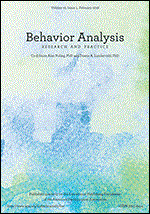Worldwide, noncommunicable diseases (NCDs) account for 71% of all deaths (World Health Organization, 2021). NCDs are also referred to as chronic diseases and include—among others—cardiovascular diseases, cancers, chronic respiratory diseases, and diabetes. Mental health conditions and injuries are also considered NCDs (Pan American Health Organization, n.d.). While genetic, physiological, and environmental factors contribute to the prevalence of NCDs, modifiable lifestyle behaviors associated with physical inactivity, poor nutrition, tobacco use, and excessive alcohol use lead to an increased risk of NCDs (World Health Organization, 2021). The majority of NCDs can be prevented or their onset and progression delayed through interventions that target behavioral risk factors.
The field of behavior analysis is well-positioned to address challenges in health, sport, and fitness including (but not limited to) those related to poor diet/nutrition, lack of exercise or physical activity, other public health problems (e.g., alcohol, drug, and tobacco use), poor athletic performance, and exercise and sport-related injuries. Practitioners can apply behavior-analytic concepts, principles, and techniques to improve health and fitness through health promotion and supporting health-related behavior change, as well as reduce injuries through behavioral coaching to teach proper physical activity-related form and technique.
The base of behavior-analytic literature on topics that fall under the umbrella of health, sport, and fitness appears to be growing alongside the increased visibility of and interest in this practice area. As evidence of this increased interest, the Behavior Analysis in Health, Sport, and Fitness Special Interest group (HSF SIG) reported a 400% increase in membership over the last four years, with 130 active (dues-paying) members as of April 30, 2021 (G. Torres, personal communication, May 27, 2021). Nonetheless, a mere .09% of certified behavior analysts identified health, sport, and fitness (HSF) as their primary area of professional emphasis as of December 9, 2020 (Behavior Analyst Certification Board, n.d.). Looking forward, I expect this percentage to increase in response to recent resources and publications to guide practitioners toward expanding their reach and scope of competence (e.g., Alligood & Gravina, 2020; Brodhead et al., 2018; Holland & Slowiak, 2021; Normand et al., 2021; Normand & Bober, 2020).
Behavioral research concerning issues relevant to health, sports performance, and fitness/physical activity surfaced in the 1960s and 1970s. Seminal works applied behavioral principles to eating behavior (Ferster et al., 1962; Stuart, 1967) and shed light on the value of a behavioral perspective to the field of sport and exercise psychology (Rushall & Siedentop, 1972). Over the past 60 years, behavioral research has covered a wide variety of topics including (but not limited to) increasing physical activity levels (e.g., Donlin Washington et al., 2016; Kuhl et al., 2015; Kurti & Dallery, 2013; Normand & Burji, 2020; Page et al., 2020; Washington et al., 2014; Zarate et al., 2019; Zerger et al., 2016), increasing daily caloric expenditure (e.g., Donaldson & Normand, 2009), improving adherence to prescribed exercise (e.g., Shepich et al., 2007), healthy eating (e.g., Hausman et al., 2014; Rafacz, 2019; Sigurdsson et al., 2014), examining the efficacy of a single session ACT intervention to initiate health-related behavior change (e.g., Barreto et al., 2019), preventing sport-related injuries (e.g., Harris et al., 2020; Quintero et al., 2020; Tai & Miltenberger, 2017), and improving athletic and sports performance (see Luiselli et al., 2011 and Schenk & Miltenberger, 2019 for reviews).
This special issue of Behavior Analysis: Research and Practice was initiated by the HSF SIG whose mission is to “educate, coordinate, and provide resources to behavior analysts and other members of society seeking to address human challenges in health, sport, and fitness through the application of the science of behavior analysis” (HSF SIG, n.d.). As part of its mission and strategic plan, the HSF SIG looks to identify ways in which it can increase awareness and visibility of applications of behavior analysis related to issues of health (broadly defined), sport, and fitness. Engaging in efforts to encourage and increase the current literature base via published research is one way to achieve this goal.
The objective of this Special Issue on behavior analysis in health, sport, and fitness is to highlight works that offer new or innovative perspectives on the role behavior analysis plays in growing this area of research and practice via (a) informing health and fitness behavior change; (b) designing and evaluating interventions to support health-behavior change or improve fitness and sport performance; and (c) identifying opportunities and recommendations to advance research and inform practice in the areas of health, sport, and fitness. The special issue is composed of empirical studies that evaluated interventions to increase exercise and physical activity among children and adults (Batchelder & Donlin Washington, 2021; Courtemanche et al., 2021; Hanashiro-Parson & Miltenberger, 2021; Krebs & Nyein, 2021; Rosado et al., 2021; Van Camp et al., 2021), reduce rapid eating behavior (May & Catrone, 2021), and improve sports performance technique (Mulqueen et al., 2021); a review of behavioral interventions to increase physical activity of those with intellectual disabilities (Page et al., 2021); and commentary on considerations related to certification, scope of practice, scope of competence, and unique ethical situations for practitioners (Holland & Slowiak, 2021).
I am incredibly grateful to all who contributed to this Special Issue, including the authors for their submissions, the many anonymous reviewers for volunteering their time and expertise to evaluate the merit of the submitted articles, and to the guest editors, Dr. Raymond Miltenberger and Dr. Carole Van Camp, and editor, Dr. Joel Ringdahl, for their great effort in making this Special Issue successful. I hope that this Special Issue can highlight new contributions in the rapidly growing application of behavior analysis plays in health, sport, and fitness, and I look forward to seeing how these contributions to the field inspire and inform future research and practice.



